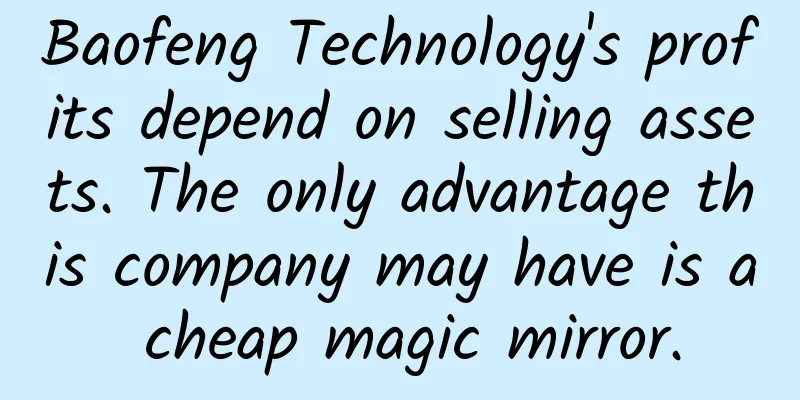Baofeng Technology's profits depend on selling assets. The only advantage this company may have is a cheap magic mirror.

|
After the VR concept and the 3 billion acquisition, investors of Baofeng Technology (300431.SZ) have received good news. The company, which became famous last year with 27 daily limit increases, achieved a turnaround in net profit in the first quarter of this year. Now, Baofeng Technology is promoting its "DT Big Entertainment Strategy". This hardware + software ecosystem concept cannot help but remind investors of the A-share legend LeTV (300104.SZ), which is the best storyteller. As a rising star, Baofeng Technology has followed LeTV's pace and made rapid progress, and even its business development and financing methods are very similar. Will Baofeng Technology become the second LeTV to tell a story in the A-share market? Profit or due to selling assetsThe annual and quarterly reports released by Baofeng Technology not long ago have both increased significantly. In the first quarter of this year, Baofeng Technology achieved operating income of 190 million yuan, a year-on-year increase of 105.76%, and a net profit of 3.395 million yuan. Prior to this, the 2015 annual report showed that Baofeng Technology seemed to be gradually on the right track: the company achieved operating income of 652 million yuan, a year-on-year increase of 68.85%. The company's net profit attributable to shareholders of listed companies was 173 million yuan, a year-on-year increase of 313.23%. But a closer look at the quarterly report shows that the net profit attributable to the parent company after deducting non-recurring gains and losses is still a loss. In other words, relying on the income from the disposal of non-current assets, Baofeng Technology turned losses into profits in the first quarter. The revenue growth in the annual report is mainly due to external mergers and acquisitions: the consolidation of the merged Baofeng Commander has brought Baofeng Technology a dazzling revenue growth. However, its endogenous development has not been highlighted: although the video on demand for content monetization has increased by 1,370% year-on-year, the performance amount is only 21.45 million yuan; its advertising revenue has only increased by 34% year-on-year. In the final analysis, Baofeng Technology's 2015 performance report seems to have grown significantly, but in fact it was all due to mergers and acquisitions. As for its own advertising and video on demand, there are no highlights. In addition, it is worth noting that Baofeng Technology issued consecutive announcements on March 30 and April 13, and the company's controlling shareholder Feng Xin pledged 1 million and 5.4 million shares for financing, accounting for 9.12% of his shares. At present, Feng Xin holds a total of 58.6003 million shares of Baofeng Technology, accounting for 21.32% of the total share capital. He has pledged a total of 41.6815 million shares, accounting for 15.17% of the company's total share capital, accounting for 70% of his shares. Interface News calculated that Feng Xin received a total of 1.81 billion yuan in additional funds based on a 50% pledge conversion rate. However, the purpose of these funds has not been disclosed. The revenue model is too singleThe following two pictures, one is LeEco's ecosystem, the other is Baofeng Technology's DT entertainment strategy. Do they look similar? That’s right, both companies are pursuing the concept of content + hardware + platform. Although their sizes are very different, they both have the same ideal: to eventually form a closed loop. The slight difference is that LeTV and Baofeng Technology focus on different content ends: LeTV focuses on film and television and sports. From the success of its Huaer Film and Television and the upcoming injection of LeTV Pictures into the listed company, we can see its emphasis on content. Baofeng Technology focuses on games, but due to the lack of content, it has spent a lot of money to acquire a number of content production companies such as Straw Bear Pictures and Gump Technology . This is also the main reason for the different sources of income for the two companies. Due to the different composition of the content side, the profit model is also very different. From the annual report data disclosed by the two companies, the proportion of revenue is also very different: in the composition of LeTV's revenue in 2015, the terminal business (hardware) accounted for 46.78%, the advertising business only 20.83%, and the paid business in the content realization link had a revenue of 20.82%, which was 2.7 billion yuan. Baofeng Technology's revenue model is more single: the main source of revenue in 2015 was advertising business, accounting for 70.9%; although the sales of hardware such as Baofeng Magic Mirror increased significantly compared with 2014, it only accounted for 20.2%, with revenue of about 130 million yuan. The video on demand in the content realization link accounted for only 3.3%, with revenue of 21.45 million yuan. From this comparison, we can see that Baofeng Technology's revenue model is too single and heavily dependent on advertising revenue. The situation in this regard is a bit similar to LeTV before 2013, when the largest revenue was also from advertising, accounting for 35.53%. Of course, it was still the early stage of the LeTV ecosystem concept. If Baofeng Technology wants to follow LeTV's old path, it must of course take the content-based path. Therefore, it is not surprising that it acquired Straw Bear Pictures at a high premium. Hardware losses and divestituresIf Baofeng Technology can only look up to LeTV on the content side, then the two companies are really in the same boat when it comes to terminals. As we all know, the losses of LeTV terminal manufacturer Zhixin have dragged down the overall profitability of LeTV.com. According to the 2015 annual report, LeTV Zhixin Electronic Technology (Tianjin) Co., Ltd. lost 386 million yuan and 730 million yuan in net profit in 2014 and 2015 respectively . As the saying goes, the more it sells, the more it loses. Baofeng Technology's situation is not much better. Its revenue in 2014 and 2015 was 5.15 million yuan and 131 million yuan respectively, and its cost was 4.94 million yuan and 120 million yuan respectively. Although it is slightly profitable from the perspective of gross profit margin, the net profit situation is predictable. Naturally, leaving losses in the listed company is not conducive to performance, and the two companies have divested their hardware manufacturers at the same time. As for Baofeng Technology, the company announced in August 2015 that it plans to transfer its 11% stake in Baofeng Magic Mirror to Baofeng Holdings (Beijing) Co., Ltd. and Huang Xiaojie. After this equity transfer, the company holds 19.84% of Baofeng Magic Mirror and is no longer included in the scope of consolidation. Speaking of divestiture, Feng Xin, CEO of Baofeng Technology, once said in public that "we are also in pain" because the losses of Baofeng Magic Mirror during its growth period will drag down the company's performance and the practice of reducing holdings to less than 20% can be excluded from the company's losses. However, LeTV.com only holds 58.33% of the shares of LeTV Zhixin, a hardware manufacturer, and is not a wholly-owned subsidiary. In terms of accounting, all losses will not be accounted for in the listed company. As a result, there will be a net profit loss and a net profit attributable to the parent company. Baofeng Technology and LeTV have similar layouts for hardware manufacturers: LeTV Zhixin participated in the investment in TCL Group, and Baofeng Technology also invested in Tongshuai Chuangzhijia at the end of 2015. It is an electronic brand under Haier Electric Appliances, which can also be understood as being tied to Haier Electric Appliances. The two companies tied up with traditional electrical appliance manufacturers to reduce manufacturing costs, which is also a good intention. Unique VR concept pioneer or martyr? The software content is not as good as LeTV, and the hardware is comparable to LeTV, but Baofeng Technology has businesses that LeTV does not have: games and VR. In a letter to shareholders in its annual report, Baofeng Technology singled out VR for discussion, and even mentioned that the scale of Magic Mirror users has exceeded 1 million. According to the platforms announced by Baofeng Technology, there is also a VR platform, namely the long video platform Baofeng Video, the short video platform Show, the hardware platform Baofeng TV, and the VR platform Baofeng Magic Mirror. As the hottest investment field at present, the sense of capital in VR is often faster than the development speed of the industry. At present, whether in the international or domestic market, products cannot avoid the problems of dizziness and particles. From the existing Oculus Rift, HTC Vive and Sony's PlayStation VR products, the price range of hardware ranges from 4,000 to 7,000 yuan. In contrast, the price of Baofeng Magic Mirror on its official website is only 499 yuan. Its principle is just the three-dimensional sense of optical imaging, not to mention the immersive experience of the content. Looking at Baofeng Technology's annual R&D investment, it was only 136 million yuan in 2015, and only 83 million yuan and 93 million yuan in the previous two years. However, HTC VIVE's R&D investment for a single product is at least more than 100 million US dollars (about 649 million RMB). The disparity in investment determines the quality and future of the product. Baofeng Technology's sincerity can be seen from its products. As for relying on the acquisition of Gump Technology, Lidong Technology and Straw Bear Pictures to supplement the content shortcomings, Baofeng Technology has a longer way to go. In fact, Baofeng Technology's VR situation is far less stable than its secondary market performance. First, LeTV and other content producers have entered the VR industry, and then Tencent and other BAT companies have increased their investment in games. From the current perspective, Baofeng Technology's only advantage is the launch of the less technical Baofeng Magic Mirror, but no one can see how long this advantage can be used. On April 26, Baofeng Technology rose 1.55% to close at 72.24 yuan, with a total market value of 19.9 billion yuan. This price has fallen by half compared to its high point after listing. As a winner of Toutiao's Qingyun Plan and Baijiahao's Bai+ Plan, the 2019 Baidu Digital Author of the Year, the Baijiahao's Most Popular Author in the Technology Field, the 2019 Sogou Technology and Culture Author, and the 2021 Baijiahao Quarterly Influential Creator, he has won many awards, including the 2013 Sohu Best Industry Media Person, the 2015 China New Media Entrepreneurship Competition Beijing Third Place, the 2015 Guangmang Experience Award, the 2015 China New Media Entrepreneurship Competition Finals Third Place, and the 2018 Baidu Dynamic Annual Powerful Celebrity. |
Recommend
Medical Device Review: The Wonderful Principle of Ventilators in the Fight against the New Coronavirus
Source: China Device Evaluation...
A guide to placing game ads on Toutiao today!
On Toutiao , there are 50 million people who play...
HarmonySpace Hongmeng cockpit large-scale OTA upgrade brings users a smarter interactive experience
Since October, the Hongmeng cockpit based on Harm...
A must-have user growth map for new product developers
User growth is an eternal topic in the Internet c...
For information flow advertising sponsors with large budgets, what kind of material and copywriting can make them earn a fortune?
After reading this article, I hope you can improv...
iPhone is expected to provide real-time handwriting recognition technology to support Chinese character input
Apple seems to be actively developing a handwriti...
Tips for setting up a GuangDianTong information flow account!
How to choose from so many slots? How can we achi...
Who is the "murderer" in the down jacket explosion incident? There may be more than one truth!
Recently, there have been reports of down jackets...
Download Little Fox Back Beauty Course Baidu Cloud
Little Fox Back Beauty Course Resource Introducti...
Microsoft Surface Pro 4 is coming: Will it completely replace the PC?
In two days, on the morning of October 6, US time...
Do dung beetles also "pick up poop"? Why do they roll dung balls?
Expert: Zhang Qikai, Chinese Academy of Agricultu...
Mango TV's president changed due to Hunan Radio and Television Group's listing
Zhang Ruobo, general manager of Happy Sunshine In...
Why do users convert?
Before you start reading this article, please thi...
A fund course that you can learn in one go and become the best money-maker in your circle of friends!
The training course on how to play funds recommen...
Lack of this vitamin may lead to Alzheimer's disease...
Reviewer of this article: Chen Haixu, Deputy Dire...









